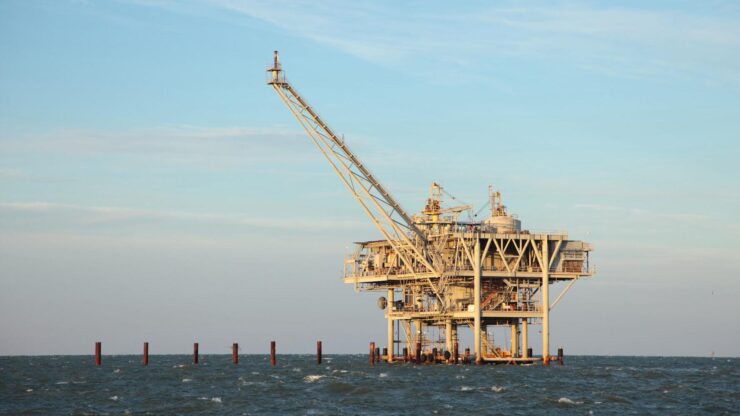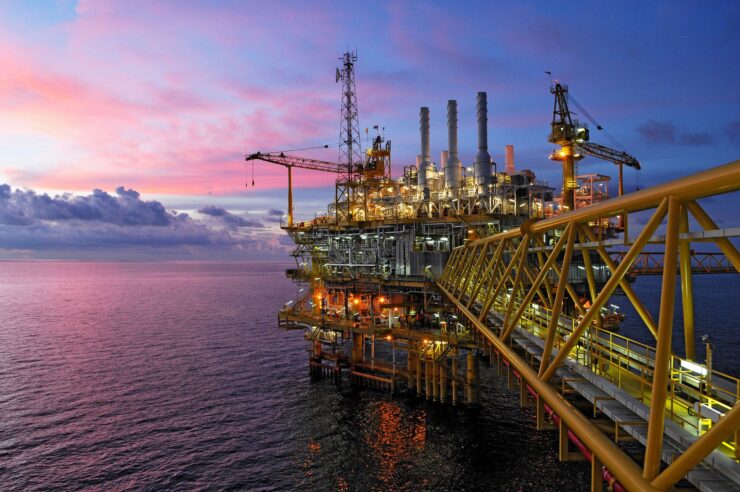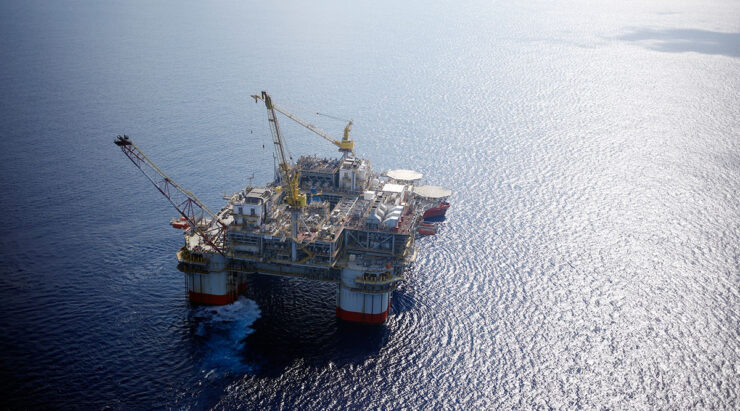Fishing Louisiana offshore oil production platforms (rigs, wellheads) can prove successful, if you know the right methods, tips, tactics, how-to, and techniques.
Off the coast of Louisiana lies some of the world’s most unusual reefs. We’re not talking about coral or shell reefs, but the steel legged kind that the oil companies constructed throughout the waters of the Gulf of Mexico. No doubt the engineers of these structures gave little thought at the time of their development on how an important food chain would result due to these rig installations.
As a result of this, many fish gather under and near the leg stuctures of these steel reefs which are found in waters under ten feet to over a thousand feet in depth.
Some have wondered, what attracts fish to these structures? Basically speaking, two factors: Shelter and food. The food chain begins with the formation of barnacles on these structures below the waterline. This sets the stage for small fish seeking shelter and food that the steel legsred bottom rigprovide. Also, added to this food chain is food disposal that is thrown overboard by the rig personnel. These combined factors draw the smaller fish that the larger fish feed on. In essence, the rig structure serves as a big oceanic chumming machine. Of course the final links in the chain are the commercial and sport anglers who are drawn to these reaping grounds to gather the bounty found therein.
While anglers in some other states along the Gulf find it essential to use a GPS to locate their fishing spot, such an instrument isn’t a must when rig fishing. Obviously, this doesn’t mean that a GPS isn’t worth having. However, one can get by without it to rig fish if you have an “accurate compass” and good visibility.
An “accurate compass” means one that is mounted in an area unaffected by moving magnetic metal objects and reads correctly on any given compass heading. One culprit that can impede a compass from reading accurately is a steel steering wheel-or for that matter, any metal object located too close to the compass. Keep in mind that a plastic steering wheel has a metal core and thus it too can be a cause for concern.
A compass that reads just a few degrees off can put you miles of course. To check to see if your compass is affected by the steering wheel, put your boat in the water (least influenced by wind and waves) out of gear. Turn your wheel from left to right and observe the compass reading. If the reading swings or fluctuates as you moves the wheel, you need to relocate the compass out of that magnetic field. Also, once the compass is in an area that doesn’t influence its reading, compare the boat’s compass reading with a hand held compass, clear of the boat’s compass and steering wheel. If the reading is not accurate, adjust it as necessary according to instructions received with your compass or have it professionally calibrated.
Another essential for rig fishing is a “rig hook,” since anchoring won’t be practical in deeper depths of water, not to mention obstructions and pipes that often lurk below. A rig hook, for those of you who don’t know, is a hooked shaped aluminum pipe of 8 or more feet in length, used to attach to the rails and cross pipes of a rig. At least 50 ft. of 1/2 inch braided nylon rope should be used for mooring. To keep the rig hook from straightening under tension, attach at least a 3 ft. length of rubber shock leader between the main rope and rig hook shank eyelet. A safety rope of at least double the length of the shock leader should be fastened between the rig hook shank eyelet and main rope. This will prevent the boat from detaching from the rig hook should the rubber shock leader ever break.
Before hooking up to any rig structure, it is very important to consider these factors: Current and wind direction. I have seen anglers latch onto an oil rig only to have the bp 190 rigcurrent and/or wind slam the boat into the structure before they could disconnect and back away.

To determine the down current side of the rig, place the the boat in neutral, away from the rig, and watch which direction the boat moves to. Make sure that the forward momentum of the boat is not in question before making the final determination.
The next thing to check is overhead clearance. Make sure the boat clears any obstruction like bridged walkways, overhangs, and discharge pipes. Even when these things look alright, if you moor too close to the rig you could possibly be urinated on by a rig worker or doused with hot ammonia from a discharge pipe. Since some of these rigs operate 24 hours, it is worth while to take these precautions seriously, or you could find yourself in a very precarious situation.
Despite having to take necessary precautions, offshore fishing can be both enjoyable as well as surprising. Unlike fishing inside waters, where you basically know what you’ll catch, offshore fishing can present an unexpected encounter.
Though there are a number of different offshore oil fields off the Louisiana coast, the steel legged reefs found in the West Delta Blocks are considered to be among the more popular. Empire and Venice, Louisiana, boasts a long list of charter services vailable throughout the week that run out to a number of these rigs.
West Delta 41-B, for example, is only one of the popular West Delta rigs anglers like to fish. Compass heading 224 degrees from the Empire Jetties will put you 13 miles out and in 90 feet of water.
Other articles you might like:
This rig is actually three rigs in one and is bridged in a “L” shape with rig stations at each point. It is recognized at night by a red light atop it’s tall tower. Block 41-A makes up part of this L- shaped structure. Particularly during the winter and summer months, both charter crews and sport anglers like coming here to catch king mackerel and other typical bottom feeders like snapper and white trout.

West Delta 73-A and 74-F are two other rigs that are also frequently visited by anglers. These two rigs are excellent bottom fishing spots and are located in 174 ft. of water. 73-A can be reached by taking a compass heading of 192 degrees from the Empire jetties. Both of these rigs are within easy eye sight of the other.
Identifying these structures is made easy by the oil companies. On each rig, including wellheads often found in shallower waters, is a sign designating the oil company’s name, rig number, and block location.
Among other species, bull croaker, white trout, snapper, grouper, redfish, spadefish, and sheepshead are generally caught at these rigs. Various cut baits like squid, mullet or porgies (menhaden) will usually bag these fish. However, a very productive bottom fishing leader rig, besides the usual Carolina rig (or sliding sinker rig), is a combination hook and lure bottom rig.
To make this, fashion a tandem bottom drop leader rig from a single 5 ft. length of 30 lb. clear mono. For the hook drops double back the mono leaving a about a foot length for each drop and double knot them at the main leader line. It is important to pull the mono at opposing ends to tighten the knots so they don’t slip. The hooks can be looped onto the ends of the drops. Or you can cut one section out of the double backed line at the main leader line and opposite end, and then tie the hooks to the ends of the drops.
The top section will be looped and double knotted for attaching to the tag end of the reel line. The first and second drops should be about a foot apart from each other. Use #7/0 blue Aberdeen hooks (not a weighted jig head hooks). Onto the hooks slide a chartreuse Sparkle Beetle refill up the straight section of the hook shank with the curved part of the hook between the split tail of the lure. On the bottom drop, tie or loop on a weight of sufficient amount.
Put a strip of squid or mullet on the hook and fish it in a jigging fashion. This will work fine at various depths and fished on the bottom. After the fish are worked up into a feeding frenzy, bait may be eliminated from the hooks.

